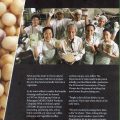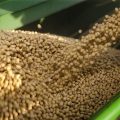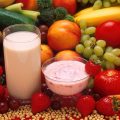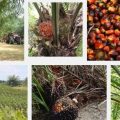There is more to the soybean than just the simple bean we know.

Soybean was a wild plant growing from five to six feet tall with large physical structure and few seeds and primarily used as forage crop. It was the Chinese that domesticated it. Called “Wu Ku” in ancient China, soybean was considered as one of the five sacred grains, with rice, wheat, barley, and millet among the others, and was sown with great ceremony by the emperors. It was first domesticated in the 11th century B.C in the eastern half of North China. The cultivated soybean was introduced to Korean then into Japan. It reached the United States through the seeds brought by Samuel Bowen, a seaman, from China via England and was first planted in Georgia in 1725. It made its way to the Philippines in the 17th century. It became an important food crop only in the 1920s.
In describing the soybean, Peter Marshall and Dan Imhoff said that, it is only now that the soybean is understood. It is a plant of complexity and contradiction. It possesses the characteristics of both animal protein and fuel oil; can be rendered into a meat like fiber at the same time a cow like milk. Sometimes it is referred to as “Cow of China,” While it can provide low vegetable protein, it is also the mainstay of the livestock feed industry. The soybean is relatively a self-sufficient crop possessing the soil enriching properties of leguminous plants-the ability to draw nitrogen from the air and transfer this to the roots.
The soybean can be turned into many products such as soy flour for bakery products, soy protein extracts, defatted soy flakes, soy meat, soy concentrates, so isolates and full fat flour. From soy fatted flour, a cheap meat substitute for bacon can be made. A non-dairy ice cream which is a blend of tofu, soy milk, and other soy protein is a favorite of weight watchers in the U.S.
Shortages in printing ink in the 1990s led to the quest for an alternative and soy oil was singled out 2000 other plant formulations. The printers found this to be relatively inexpensive, had acceptable viscosity that allowed pigments to show through more sharply and brilliantly. By 1997, one third of U.S. newspapers used longer and is easier to clean up. Soybean oil is also used to produce rigid urethane foam and soy protein can be used to improve the properties of polyurethane foams, increasing their strength, flame resistance and their biodegradability.
Now, I can associate what the painter of our house was saying when he extolled the virtues of polioritin, which at that time I did not understand. But my chemical engineer son came to the rescue and told me that what the painter was saying was polyurethane coating, the floor does not burn.
In an article by Dr. Harry Synder of the Volunteers in Technical Assistance (VITA), soybean is a valuable part of the world’s food supply and the systems that produce and deliver food. The production has grown rapidly and while it is widespread, soybeans is mostly produced in temperate countries with the United States producing half of the total followed by Brazil, China, and Argentina. The Philippines cannot produce its own soybeans needs and so it is the biggest importer of U.S soybean meal and the import is increasing. Our country buys about 300,000 tons of soybeans and the three soybean crushing companies import one million metric tons of soy meal yearly for the poultry and swine industry. And then, if one considers the food products that we are buying from the U.S. then we are importing more. Soybean is said to be present in 60 percent of processed food eaten everyday.
Now, I remember the puddling noise similar to washing clothes by the women in the community where I lived but that was three decades ago. They do not plant this crop anymore. Why can’t soybean be produced in our country? If this is an off-season crop, a crop after rice, then maybe it can take the place of tobacco or a part of the tobacco areas. Five regions had been growing tobacco in the country so this is a big area for soybean.
Aside from generating income, it also helps in breaking the pest and disease cycle associated with continuous cropping of the same crop. Cagayan Valley is a producer of soybean in the country but only planted for its nitrogen-fixing nodule that enriches the soil for rice production. Isabela has tried making ice cream using soy milk as base.
The problems identified for soybean are not on the production aspect but on postharvest-physical injuries to the seeds, lack of drying facilities and lack of market. With the global demand and the manifold uses of the crop, could lack of market be a problem? ####
By: Virginia A. Duldulao, Ph.D, BAR Chronicle, June 2002 Issue (Vol. 3 No. 11-12)






